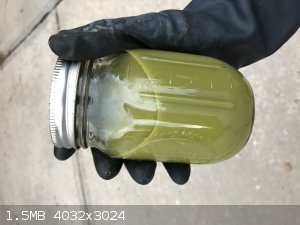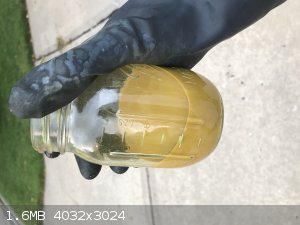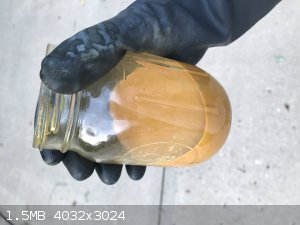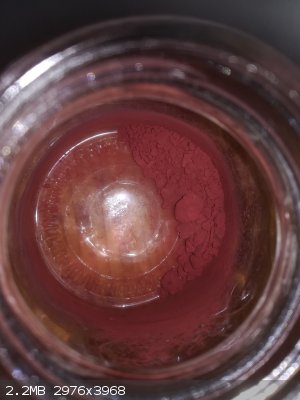| Pages:
1
2 |
Arcaeca
Hazard to Self
 
Posts: 70
Registered: 24-8-2019
Location: Kansas, USA
Member Is Offline
Mood: brøthér, can you spare some B̲̺̹̙̑́̓́ͧ̎ͭ̈́͜L̰̦̼̻͈͖̺͔̇̇̿ͪ̓̃̽ͦŲ̘̲̻͔̀͌͑͑̊͛̑̀͊̕E̐ͮͯ͆̔̾͘͏҉̥̫
|
|
Trying to make red copper & iron oxides
(I posted this thread once before, but my account and all associated threads got auto-deleted, so apologies to anyone who already answered this, but I
never got to see the replies)
So in my quest to make pigments from scratch, I've determined that iron(III) oxide and copper(I) oxide are probably my best bets for making red
pigment, since the materials are easy to get my hands on and are much less toxic than, say, mercury, lead or arsenic that you find in other red
mineral dyes.
The problem is both these oxides have both a yellow form and a red form, and I haven't had luck making specifically the red form.
Iron(III) oxide is quite easy; you can just dissolve some iron metal in hydrogen peroxide for a short amount of time, but that's only ever gotten me
the yellow variant, except for once, on accident, when I turned the solution blood-red on addition of H2O2, but I can't seem to
reproduce the result.
Keeping the iron metal in hydrogen peroxide (or even just water, for that matter) for longer periods of time yields a product that's
redder... but not red. More in the dark orange to reddish-brown color range.
Copper(I) oxide is even trickier; supposedly you can make it by simply heating copper metal in air, but when I try this it quickly oxidizes further to
black copper(II) oxide, which is suitable as black pigment - just not what I'm trying to make. There are various tutorials for making copper(I) oxide
out there, most of which are variations of Benedict's Test, but they seem to also mostly produce the yellow copper(I) variant.
But someone, somehow, is making vibrant red variants of iron(III) oxide and copper(I) oxide, based on what Google Images pulls up, and I
can't figure out how.
How can I produce the most vibrant red from iron or copper given my limited toolset?
|
|
|
Bedlasky
International Hazard
    
Posts: 1219
Registered: 15-4-2019
Location: Period 5, group 6
Member Is Offline
Mood: Volatile
|
|
Hi.
Red Cu2O is easily made by reducing Cu(OH)2 with excess of glucose, fructose or invert sugar. I never made yellow Cu2O by this method.
|
|
|
Felis Corax
Harmless

Posts: 35
Registered: 26-7-2019
Location: These Uninted States of Murica
Member Is Offline
Mood: Pre-project euphoria
|
|
Electrolysis of iron in an NaCl solution will yield a goopy hydrate which can be dried to get anhydrous FeO(OH). My results were in the brownish red
range, so not exactly what you're after, but it might provide a starting point.
Nothing is pure, nothing is perfect, nothing is clean.
|
|
|
lab-equip
Harmless

Posts: 13
Registered: 8-10-2016
Member Is Offline
Mood: No Mood
|
|
Cooper(Ii)sulfate in H2O with aluminiumfoil creates Red Cooper(i)oxid
|
|
|
icelake
Harmless

Posts: 48
Registered: 9-10-2017
Member Is Offline
Mood: No Mood
|
|
That's elemental copper not the oxide.
|
|
|
lab-equip
Harmless

Posts: 13
Registered: 8-10-2016
Member Is Offline
Mood: No Mood
|
|
Just recognizes IT right now was not Fehling aorry
|
|
|
Arcaeca
Hazard to Self
 
Posts: 70
Registered: 24-8-2019
Location: Kansas, USA
Member Is Offline
Mood: brøthér, can you spare some B̲̺̹̙̑́̓́ͧ̎ͭ̈́͜L̰̦̼̻͈͖̺͔̇̇̿ͪ̓̃̽ͦŲ̘̲̻͔̀͌͑͑̊͛̑̀͊̕E̐ͮͯ͆̔̾͘͏҉̥̫
|
|
Quote: Originally posted by Bedlasky  | | Red Cu2O is easily made by reducing Cu(OH)2 with excess of glucose, fructose or invert sugar. I never made yellow Cu2O by this method.
|
This sounds... suspiciously like Benedict's test. But those are literally all the reagents needed? Copper hydroxide and reducing sugar?
(Actually, now that I think about it, where would I even get glucose? I have sucrose, and from what I understand a little bit of weak acid like
tartaric or citric acid can catalyse its decomposition to glucose?)
[Edited on 8-26-2019 by Arcaeca]
|
|
|
Bedlasky
International Hazard
    
Posts: 1219
Registered: 15-4-2019
Location: Period 5, group 6
Member Is Offline
Mood: Volatile
|
|
It have same principle like Benedict's test. With Benedict's test you also make red Cu2O. Glucose form with Cu(OH)2 soluble complex (as many
polyhydroxy compounds). So if you use excess of glucose you don't need citrate and all of Cu(II) is reduced in to Cu(I).
Glucose you find in most of food shops. Or you can prepare invert sugar from sucrose as you suggested. Dissolve sucrose with small amount of acid and
heat it for 20-30 minutes. You've get mix of glucose and fructose which form complex with Cu2+ and reduce it in to Cu2O.
|
|
|
Arcaeca
Hazard to Self
 
Posts: 70
Registered: 24-8-2019
Location: Kansas, USA
Member Is Offline
Mood: brøthér, can you spare some B̲̺̹̙̑́̓́ͧ̎ͭ̈́͜L̰̦̼̻͈͖̺͔̇̇̿ͪ̓̃̽ͦŲ̘̲̻͔̀͌͑͑̊͛̑̀͊̕E̐ͮͯ͆̔̾͘͏҉̥̫
|
|
Okay, so, I took a solution of copper(II) acetate and added enough NaOH for it to become cloudy and roughly the color #007FFF (I'm not actually
measuring any quantities - more just eyeballing everything), which I took to be insoluble Cu(OH)2.
Then, I a couple spoonfuls of sugar and about 1 spoonful of solid citric acid in about 250 mL of water (all approximate) and heated on high for ~25
minutes.
Then I added as much of the glucose solution to the hydroxide solution as would fit in the jar; once green, I decanted half of the solution into a
separate jar and topped it off again with more glucose solution, which turned yellow. After a couple minutes it turned orange-ish.
I'm not sure if it's supposed to turn even redder with time, but I'm guessing this is a mixture of both the yellow and red forms of copper(I) oxide.
  
|
|
|
Bedlasky
International Hazard
    
Posts: 1219
Registered: 15-4-2019
Location: Period 5, group 6
Member Is Offline
Mood: Volatile
|
|
No, this isn't mix red and yellow oxide. It looks orange now but after drying it will be red.
One small advice: After mixing of sugar solution with Cu(OH)2 heat reaction mixture (water bath is sufficient). Reaction will be much faster.
Temperature also affect's colour. If Cu2O is formed in cold solution it sometimes looks yellowish brown, if is formed in hot solution it looks orange.
I don't know if Cu2O from cold solution turns in to red after drying, but Cu2O from hot solution definitely turns in to red.
This is photo of my Cu2O which I made by this method.

[Edited on 27-8-2019 by Bedlasky]
|
|
|
sciece nerd
Harmless

Posts: 25
Registered: 27-8-2019
Member Is Offline
|
|
Would this method work with basic CuCO3 and vitamin C/sodium ascobate?
[Edited on 28-8-2019 by sciece nerd]
|
|
|
AJKOER
Radically Dubious
    
Posts: 3026
Registered: 7-5-2011
Member Is Offline
Mood: No Mood
|
|
Here is a link to a patent https://patents.google.com/patent/US2474533A/en , to quote:
"This invention relates to the preparation of cuprous oxide and more specifically to the separation of cupric oxide from a mixture of cuprous and
cupric oxides.
It has long been known that cupric ammonium carbonate solutions containing an excess of ammonium carbonate, will dissolve metallic copper forming
cuprous ammonium carbonate.....
For several years attempts have been made at various times to produce a commercial grade of cuprous oxide by the distillation of solutions of copper
ammonium carbonate that had been highly reduced to the cuprous state by contact with metallic copper. A satisfactory product has never been made by
this method....
found, that if the mixed oxide produced by the above method be treated with certain water-soluble organic acids or water solutions thereof (for
example, acetic acid) under controlled conditions, the cupric oxide will be dissolved forming the cupric salt of the acid used, and leave undissolved,
or practically so, the cuprous oxide.
This patent is based on the fact that the equilibrium reaction:
Cu + Cu(ll) <---> 2 Cu(l)
is moved to the right in a mixed aqueous/organic medium (reference, see page 1, Equation 1.1 https://researchrepository.murdoch.edu.au/id/eprint/41386/1/... ).
|
|
|
Arcaeca
Hazard to Self
 
Posts: 70
Registered: 24-8-2019
Location: Kansas, USA
Member Is Offline
Mood: brøthér, can you spare some B̲̺̹̙̑́̓́ͧ̎ͭ̈́͜L̰̦̼̻͈͖̺͔̇̇̿ͪ̓̃̽ͦŲ̘̲̻͔̀͌͑͑̊͛̑̀͊̕E̐ͮͯ͆̔̾͘͏҉̥̫
|
|
Okay, so... if I'm interpreting this correctly...
Prepare a solution of [Cu(NH3)4]CO3, and add excess NH4CO3 to the solution (which really
doesn't sound that different from just preparing (NH4)2CO3(aq) and then adding copper metal, but okay). Then add a
water-soluble acid like acetic acid (or presumably HCl) and Cu2O should precipitate out?
And the (NH4)2CO3(aq) would be synthesized by... what, dissolving CaCO3(s) in NH4OH(aq)?
|
|
|
DraconicAcid
International Hazard
    
Posts: 4278
Registered: 1-2-2013
Location: The tiniest college campus ever....
Member Is Offline
Mood: Semi-victorious.
|
|
Quote: Originally posted by Arcaeca  | Okay, so... if I'm interpreting this correctly...
Prepare a solution of [Cu(NH3)4]CO3, and add excess NH4CO3 to the solution (which really
doesn't sound that different from just preparing (NH4)2CO3(aq) and then adding copper metal, but okay). Then add a
water-soluble acid like acetic acid (or presumably HCl) and Cu2O should precipitate out?
And the (NH4)2CO3(aq) would be synthesized by... what, dissolving CaCO3(s) in NH4OH(aq)?
|
Dissolve CuCO3 (or a reasonable facsimile thereof in concentrated aqueous ammonia. Add some dry ice to get some ammonium carbonate formed.
Add copper metal to reduce the copper(II) to copper(I). The dilute to get the copper(I) oxide.
Please remember: "Filtrate" is not a verb.
Write up your lab reports the way your instructor wants them, not the way your ex-instructor wants them.
|
|
|
sciece nerd
Harmless

Posts: 25
Registered: 27-8-2019
Member Is Offline
|
|
Can I substitute ammonium sulfate+sodium carbonate for ammonium carbonate?
|
|
|
DraconicAcid
International Hazard
    
Posts: 4278
Registered: 1-2-2013
Location: The tiniest college campus ever....
Member Is Offline
Mood: Semi-victorious.
|
|
I don't see why not.
Please remember: "Filtrate" is not a verb.
Write up your lab reports the way your instructor wants them, not the way your ex-instructor wants them.
|
|
|
Bedlasky
International Hazard
    
Posts: 1219
Registered: 15-4-2019
Location: Period 5, group 6
Member Is Offline
Mood: Volatile
|
|
Ammonium carbonate isn't necessary. Ammonia solution itself is enough. Point is convert Cu(OH)2 in to soluble [Cu(NH3)4]2+ and reduce it with
something. In my opinion this is too slow and smelly. Ammonia is toxic and have disgusting smell so you must work outside. Another thing is that
copper reduce Cu2+ only slowly.
I don't understand the additon of acetic acid. Cu2O precipitates from basic solutions.
HCl will contaminate your product with white insoluble CuCl.
Yes. But I am not sure that ascorbic acid reduce copper carbonate. Maybe will be better if you dissolve copper carbonate in basic citrate solution.
But there are cheaper reducing agents then ascorbic acid...
|
|
|
sciece nerd
Harmless

Posts: 25
Registered: 27-8-2019
Member Is Offline
|
|
So, I make a basic citrate solution by adding sodium bicarbonate to citric acid, then add basic CuCO3
and sodium ascobate(made by mixing ascorbic acid and sodium bicarbonate) to get Cu2O?
I use ascorbic acid because I have over 400 grams of it left on a previous experiment.
|
|
|
Bedlasky
International Hazard
    
Posts: 1219
Registered: 15-4-2019
Location: Period 5, group 6
Member Is Offline
Mood: Volatile
|
|
I am not sure if sodium bicarbonate is sufficient. It's only very weak base and you need strongly alkaline solutioun (pH 10 or more). But with sodium
carbonate or hydroxide it will definitely work.
|
|
|
DraconicAcid
International Hazard
    
Posts: 4278
Registered: 1-2-2013
Location: The tiniest college campus ever....
Member Is Offline
Mood: Semi-victorious.
|
|
Quote: Originally posted by Bedlasky  | Ammonium carbonate isn't necessary. Ammonia solution itself is enough. Point is convert Cu(OH)2 in to soluble [Cu(NH3)4]2+ and reduce it with
something. In my opinion this is too slow and smelly. Ammonia is toxic and have disgusting smell so you must work outside. Another thing is that
copper reduce Cu2+ only slowly.
|
The slow reaction time is correct- I did a small project once where I made vials of copper(I) complexes by putting copper ribbon in solutions of a
good ligand and a copper(II) salt. Chloride, bromide and iodide all gave colourless solutions after a few hours, but the ammonia (at regular ammonia
pH- no carbonate or hydroxide added) stayed blue for days (at which point I gave up and added a reducing agent, possibly sulphite. It's still pale
blue).
Please remember: "Filtrate" is not a verb.
Write up your lab reports the way your instructor wants them, not the way your ex-instructor wants them.
|
|
|
Bedlasky
International Hazard
    
Posts: 1219
Registered: 15-4-2019
Location: Period 5, group 6
Member Is Offline
Mood: Volatile
|
|
I once reduce CuSO4 in NaCl solution with copper wire and I've got brown solution which was some mixed Cu+/Cu2+ complex. How did you make colourless
solution?
Iodide reduce Cu2+ immediately if I know. Or there are some conditions in which reaction is slow?
|
|
|
DraconicAcid
International Hazard
    
Posts: 4278
Registered: 1-2-2013
Location: The tiniest college campus ever....
Member Is Offline
Mood: Semi-victorious.
|
|
Quote: Originally posted by Bedlasky  | I once reduce CuSO4 in NaCl solution with copper wire and I've got brown solution which was some mixed Cu+/Cu2+ complex. How did you make colourless
solution?
Iodide reduce Cu2+ immediately if I know. Or there are some conditions in which reaction is slow? |
I put it in a closed vial with excess HCl and excess copper. The brown colour slowly fades away in the absence of oxygen. You can open it, watch it
go brown, and close it to watch the colour fade again.
Iodide does immediately reduce copper(II) to copper(I), but in the presence of copper wire and excess potassium iodide (and the absence of air), the
KCuI2 stays in solution, and the iodine reacts with the copper. The solution does have to be acidic, though, or you get basic copper compounds
precipitating (don't know the actual composition, but it was green).
Please remember: "Filtrate" is not a verb.
Write up your lab reports the way your instructor wants them, not the way your ex-instructor wants them.
|
|
|
Bedlasky
International Hazard
    
Posts: 1219
Registered: 15-4-2019
Location: Period 5, group 6
Member Is Offline
Mood: Volatile
|
|
Thank you very much! I'll try it someday.
|
|
|
Arcaeca
Hazard to Self
 
Posts: 70
Registered: 24-8-2019
Location: Kansas, USA
Member Is Offline
Mood: brøthér, can you spare some B̲̺̹̙̑́̓́ͧ̎ͭ̈́͜L̰̦̼̻͈͖̺͔̇̇̿ͪ̓̃̽ͦŲ̘̲̻͔̀͌͑͑̊͛̑̀͊̕E̐ͮͯ͆̔̾͘͏҉̥̫
|
|
Update: I synthesized a significant amount of reddish-orange copper(I) oxide using the reducing sugar method, but I got tired of waiting for the
liquid to evaporate, so I tried boiling it off. Being a dumbass, I forgot that sugar carmelizes at high temperatures, so now my copper(I) oxide is in
a syrup solution rather than an aqueous solution. Despite the discoloration, I will admit that it smells more pleasant now.
|
|
|
Arcaeca
Hazard to Self
 
Posts: 70
Registered: 24-8-2019
Location: Kansas, USA
Member Is Offline
Mood: brøthér, can you spare some B̲̺̹̙̑́̓́ͧ̎ͭ̈́͜L̰̦̼̻͈͖̺͔̇̇̿ͪ̓̃̽ͦŲ̘̲̻͔̀͌͑͑̊͛̑̀͊̕E̐ͮͯ͆̔̾͘͏҉̥̫
|
|
Okay, so I retried this 3 months later and I'm still just getting a bright orange instead of red when I make the copper(I) oxide. I dissolve as much
copper(II) sulfate as I can in 10 - 12 oz of water, add enough NaOH to turn it into to copper(II) hydroxide until hot and gelatinous, then top off the
mason jar with reducing sugar solution (not saturated AFAIK but pretty concentrated), cover, shake, and leave in a steaming hot water bath. And I'm
still not getting red - just bright orange. What am I doing wrong?
It also seems to be fine enough particulate that it keeps seeping through the coffee filters when I try to filter the precipitate off.
|
|
|
| Pages:
1
2 |